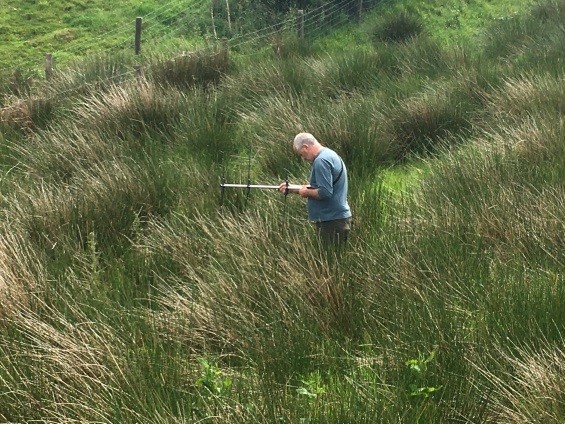It was a bitter-sweet visit to the Curlew Country project in Shropshire on June 12th. It was a baking hot day, and for a couple of hours before lunch Amanda Perkins and Tony Cross from the project, Phil Sheldrake (RSPB), Mike Smart (ace birdwatcher) and myself tried to find three or four chicks that were somewhere in a large hay meadow. They had hatched from a nest that had been surrounded by an electric fence to protect it from predators like foxes and badgers. This is the first year the project has trialled fences and it has undoubtedly increased the survival of eggs. Whether that success translates into more fledged chicks is yet to be seen. Curlew chicks have wanderlust in their blood and once they find their very large feet are fit for walking, they are off. If they are not protected by electricity, they have to rely wholly on their parents to warn them of danger.

It’s a pretty good system though. Vigilant, feisty and sneaky, curlews take parenting very seriously. Vigilant in that they can see danger approaching from a long way off, hundreds of metres, and begin yapping and barking in alarm. Feisty because it can be a full-on bombardment of sound, like being attacked with an audial machine gun. And sneaky as the alarming bird may well be quite a distance away from the chicks, leading the dangerous creature down a blind alley. Meanwhile the chicks have either sunk low into a ditch or depression, or they have legged it into impenetrable rushes – which is what they did on the day we visited.

Trying to find small fluff balls in a vast meadow is not for the weak of spirit. Tony used a radio tracker to narrow down the options, which was a patch of wet rush near to the field boundary. Try as we might we couldn’t find them, and as standing on them is a real possibility, we gave up. I was disappointed in one way, but glad in another. I am relieved they are so hard to locate, because if we couldn’t find them, even armed with technology, then a fox will find it hard too. Knowing they were there was sweet enough for me. The bleeps on the receiver were heart-lifting – I didn’t have to actually see them to feel delighted and relieved they are still in the wild. Every chick is precious, and three packages of preciousness are still in this hay meadow – or they were on Monday June 12th.
The bitter side of the visit is the knowledge that the chances of these chicks surviving is very slim. For the past two years all the chicks that managed to hatch in the project area were predated before the five to six weeks to fledging stage. Curlew are adapted to high levels of mortality – some studies suggest that each pair only needs to raise one chick every other year for a population to remain stable – but even this isn’t being met. Throughout the country, chicks and eggs are either being eaten by predators or killed by their other nemesis – agricultural machines.
In another field, this time a large grass field used for silage, Mandi showed us where at least three chicks were accidentally sliced up as silage was cut in early June. As each year a pair of curlews chose to nest in a field used to provide food for cattle – they dice with death – literally. The eggs were protected by an electric fence, and so survived to hatching, but once the chicks wandered outside they became collateral damage to our farming system. And this wasn’t the only brood to perish. Out of 22 nests located in the Shropshire project area, 9 chicks were alive on the day we visited.

Looking at the silage field and knowing the fate of the chicks was a sad way to end the day, but it was also a heartening visit too. Curlews continue to come every year to this most beautiful part of Shropshire. Every Spring they try to nest in the same places – their ancestral homes. As long as they come back there is hope we can help them. There is no shortage of goodwill amongst farmers or volunteers, everyone loves curlews. But there is a mismatch between caring about a bird and doing what it takes to save it. Sometimes that mismatch is in a lack of understanding about what is actually needed, and it is surprising how little we know about a bird that was once so common. Or it can be that money simply takes priority, and losing a silage crop is too expensive when life on a farm is stressed enough, trying to supply the market requirement for ever more and cheaper food. Or maybe it is the dilemma posed by predator control. Some people, understandably, find it hard to accept that foxes and crows may have to die so that curlews can live. Whatever the reason, curlews continue to decline across the UK at an alarming rate.
The Curlew Country project is inspirational and is doing a vital job in bringing into focus the enormous problems facing our largest wader. Nothing less than the might of UK farming, half a million badgers and foxes and a million crows bear down on them at the most fragile and vulnerable time of their lives. Curlew Country is working with everyone on the ground to find solutions, and until the last curlew calls, there is hope they will succeed in reversing the fortunes of this most wonderful and enigmatic of birds.
